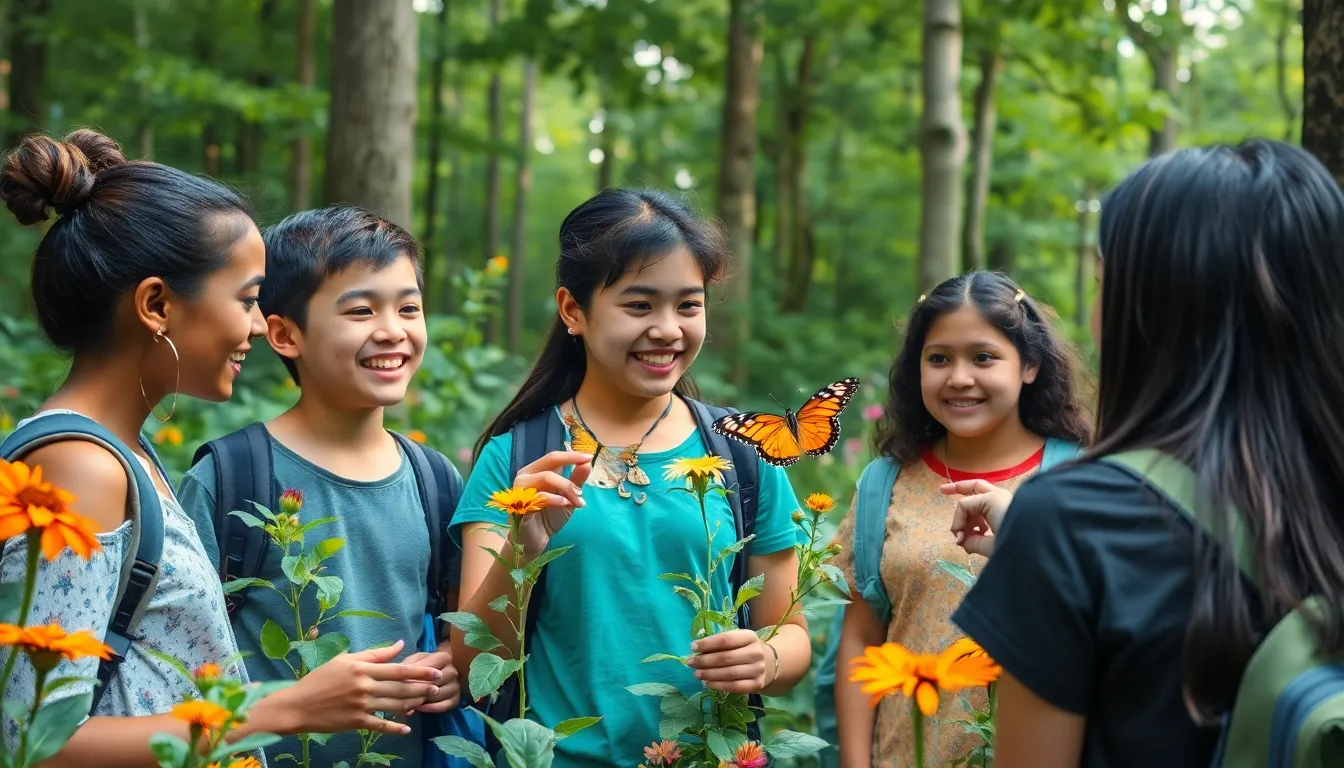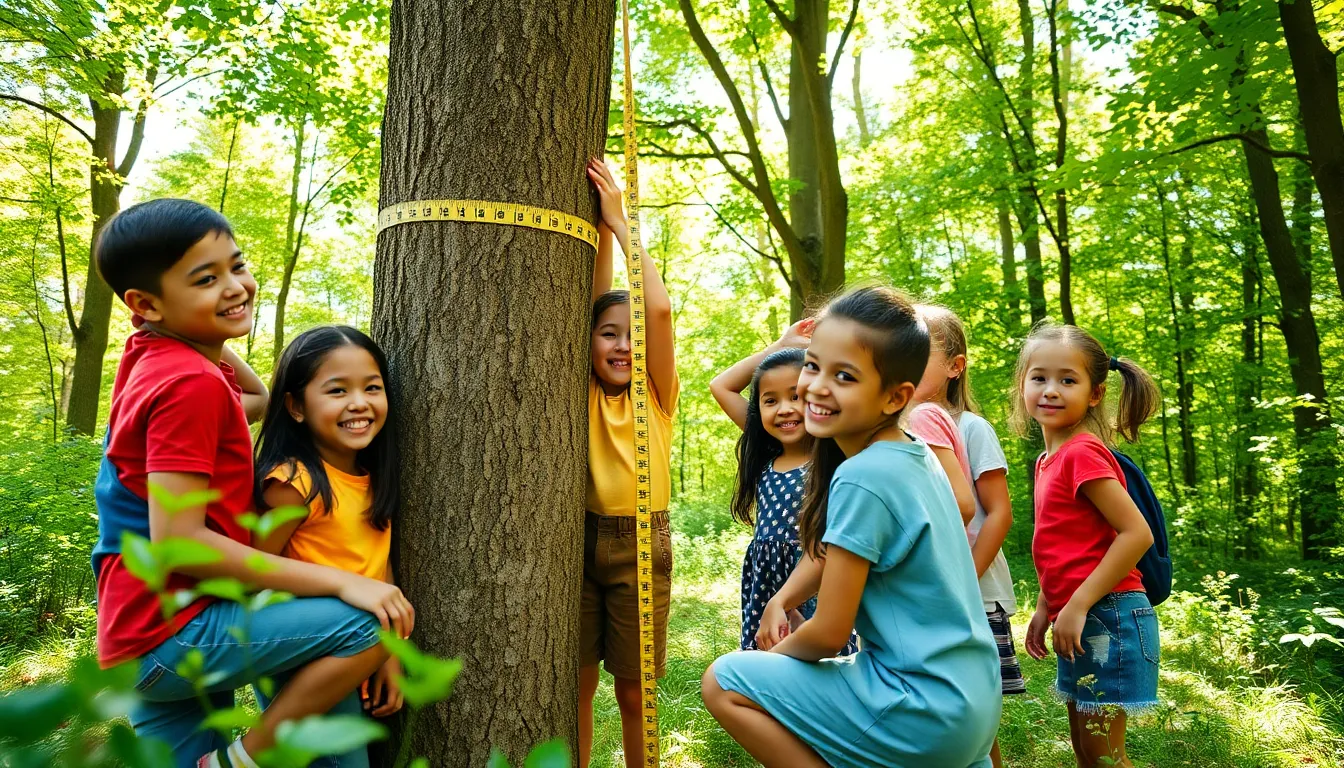Table of Contents
ToggleIn a world where screens dominate attention and nature often takes a backseat, nature immersion education is like a breath of fresh air—literally! Imagine kids trading their tablets for tree trunks and their textbooks for trails. This innovative approach not only reconnects students with the great outdoors but also boosts creativity, critical thinking, and even their ability to dodge mud puddles like pros.
Nature immersion education isn’t just about hugging trees (though that’s encouraged). It’s about fostering a deeper understanding of the environment while cultivating a sense of wonder and adventure. With every step into the wild, students gain hands-on experiences that textbooks can’t compete with. So, why not let the great outdoors be the ultimate classroom? After all, who wouldn’t want to learn multiplication while climbing a rock?
What Is Nature Immersion Education?
Nature immersion education focuses on engaging students directly with the natural environment. This educational approach prioritizes hands-on experiences in outdoor settings, allowing learners to explore and interact with various aspects of nature. Through this method, educators cultivate critical thinking and creativity by integrating subjects like math, science, and art into outdoor activities. Students often participate in tasks such as observation, exploration, and experimentation in real-world contexts.
Structured activities in nature foster a profound connection between learners and their environment. Learning outdoors offers unique opportunities for students to engage with ecosystems, wildlife, and natural processes, enhancing their understanding of complex concepts. Various programs across the country incorporate nature immersion education, from forest schools to garden-based learning.
Benefits extend beyond academic achievements. Experiencing nature contributes to emotional well-being and social skills, promoting teamwork and fostering resilience. Students develop a sense of responsibility for the environment and an appreciation for outdoor spaces, which may lead to lifelong stewardship.
Educators emphasize the role of experiential learning, making lessons memorable and relevant. The dynamic classroom provided by nature supports diverse learning styles, ensuring all students can thrive. Engaging directly with the elements nurtures curiosity and encourages a mindset open to inquiry and discovery.
Nature immersion education embodies the idea that learning can occur anywhere, inspiring students to explore and ask questions about the world around them. With increased time spent outdoors, young people build essential skills that prepare them for future challenges. The active engagement and immersive experiences found in this approach shape a generation of thoughtful and informed individuals.
Benefits of Nature Immersion Education

Nature immersion education offers numerous advantages that enhance the learning experience. Engaging with the outdoors contributes significantly to students’ overall growth.
Cognitive Development
Cognitive abilities improve through hands-on experiences in nature. Engaging directly with the environment fosters critical thinking and problem-solving skills. Students apply concepts learned in the classroom to real-world situations, making lessons more relevant and memorable. Exposure to various natural elements stimulates curiosity and inquiry, encouraging exploration. Concepts such as math and science become more approachable when applied to outdoor activities. This practical approach enhances memory retention and deepens understanding of complex ideas.
Emotional Well-Being
Emotional health benefits from time spent in nature. Interaction with natural surroundings reduces stress and anxiety significantly. Students commonly report feelings of happiness and relaxation when outdoors. Building connections with the environment fosters empathy and responsibility toward nature. Social interactions during outdoor activities promote teamwork and communication skills, enhancing relationships among peers. Positive emotions associated with nature can lead to improved self-esteem and resilience.
Physical Health
Physical health improvements are evident with increased outdoor activity. Nature immersion encourages students to engage in exercise through hiking, running, or simply exploring. Regular physical activity contributes to better cardiovascular health and strengthens muscles. Additionally, exposure to natural sunlight boosts Vitamin D levels, supporting overall well-being. Active participation in outdoor learning experiences helps combat sedentary lifestyles prevalent in traditional education settings. Benefits extend beyond physical fitness, positively impacting mental sharpness and focus.
Methods of Implementing Nature Immersion Education
Implementing nature immersion education involves various methods that directly engage students with their environment.
Outdoor Classrooms
Outdoor classrooms serve as immersive learning environments. Students learn math by measuring tree heights or calculating the area of a garden plot. Science lessons often include observing local wildlife and analyzing ecosystems. These experiences enhance retention of information compared to indoor settings. Educators design lessons around the local landscape, boosting relevance and engagement in students. Establishing consistent outdoor classroom spaces promotes regular interaction with nature. Schools can partner with local parks to create structured learning areas. Outdoor classrooms not only foster academic growth but also encourage emotional well-being and social interaction among students.
Nature-Based Activities
Nature-based activities enrich the learning experience. Exploring trails can provide opportunities for students to conduct hands-on experiments. Outdoor art projects allow learners to utilize natural materials, like leaves or stones, for creativity. Gardening teaches responsibility while providing practical lessons in biology and sustainability. Organizing nature walks enhances observational skills, fostering a sense of wonder about the environment. These activities encourage teamwork, promoting social skills through collaboration. Educators can integrate physical fitness into these events, counteracting sedentary lifestyles. Nature-based activities solidify connections to the ecosystem while providing diverse educational experiences.
Challenges in Nature Immersion Education
Implementing nature immersion education presents several challenges. Access to suitable natural spaces can limit opportunities for outdoor learning, particularly in urban environments. Schools situated in densely populated areas may lack nearby parks or green spaces, affecting the quality of experiential learning.
Weather conditions often pose significant issues. Rain, snow, or extreme temperatures can deter outdoor activities, making it essential to develop flexible lesson plans that accommodate varied climates. When unfavorable weather occurs, indoor alternatives might fail to capture the same immersive experience that nature provides.
Teacher training represents another obstacle. Many educators lack the necessary skills or knowledge to conduct effective outdoor lessons. Professional development programs focusing on nature-based teaching strategies can help bridge this gap. Understanding how to integrate traditional curricula with outdoor experiences remains vital for effective implementation.
Curriculum constraints also hinder the effectiveness of nature immersion education. Standardized testing requirements may prioritize academic subjects over experiential learning. This emphasis on testing can lead schools to allocate fewer resources to outdoor programs, limiting students’ exposure to nature’s educational benefits.
Student safety is a critical consideration. Outdoor activities often entail risks such as injuries or encounters with wildlife. Schools must implement safety protocols and equip teachers with training to manage these potential hazards effectively.
Lastly, community support influences the success of nature immersion programs. Engaging families and local organizations fosters a deeper connection to the educational process. Building a network of support enhances resource sharing and creates a stronger foundation for outdoor learning initiatives.
Future of Nature Immersion Education
Growing interest in nature immersion education suggests a promising future for this approach. Integration of educational technology alongside outdoor experiences offers enhanced opportunities for learning. Researchers support the idea that combining digital tools with nature can create hybrid learning environments that engage students actively.
Increased collaboration among educators, schools, and community organizations can drive innovation in nature immersion programs. Community gardens, nature trails, and outdoor classrooms can emerge as integral components of local educational landscapes. Support from parents and local businesses amplifies the impact of these initiatives, fostering a sense of shared responsibility.
Implementation of nature immersion education aligns with growing environmental awareness among younger generations. As students learn about ecosystems, wildlife, and sustainability, they develop lifelong skills for ecological stewardship. Students equipped with this knowledge contribute positively to their communities through informed decision-making.
Moreover, advocating for inclusive access expands the reach of nature immersion education. Schools can emphasize outdoor programs in urban settings by utilizing nearby parks and green spaces. Program development can prioritize equitable access for all students, particularly those from underrepresented backgrounds.
Adapting teacher training programs can also shape the future of nature immersion education. Professional development that focuses on experiential learning equips educators with essential skills for conducting outdoor lessons. Investing in teacher training ensures instructors feel prepared to guide students through nature exploration.
Overall, the synergy between nature immersion and educational advancements paints a bright picture for the future. The sustained push for holistic, engaging learning experiences guarantees that nature immersion education remains a vital component of academic growth.
Nature immersion education offers a transformative approach to learning that fosters creativity and critical thinking. By engaging students in hands-on experiences outdoors, it cultivates a deeper connection to the environment and enhances overall well-being.
As educational institutions continue to explore innovative methods, the integration of nature into curricula promises to create more dynamic and relevant learning experiences. This holistic approach not only benefits academic performance but also nurtures emotional health and social skills.
The future of education lies in embracing the natural world as a classroom, inspiring a generation that values both knowledge and environmental stewardship. With ongoing support and collaboration, nature immersion education can become a cornerstone of modern learning.




